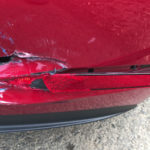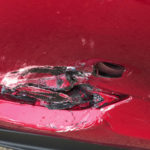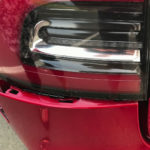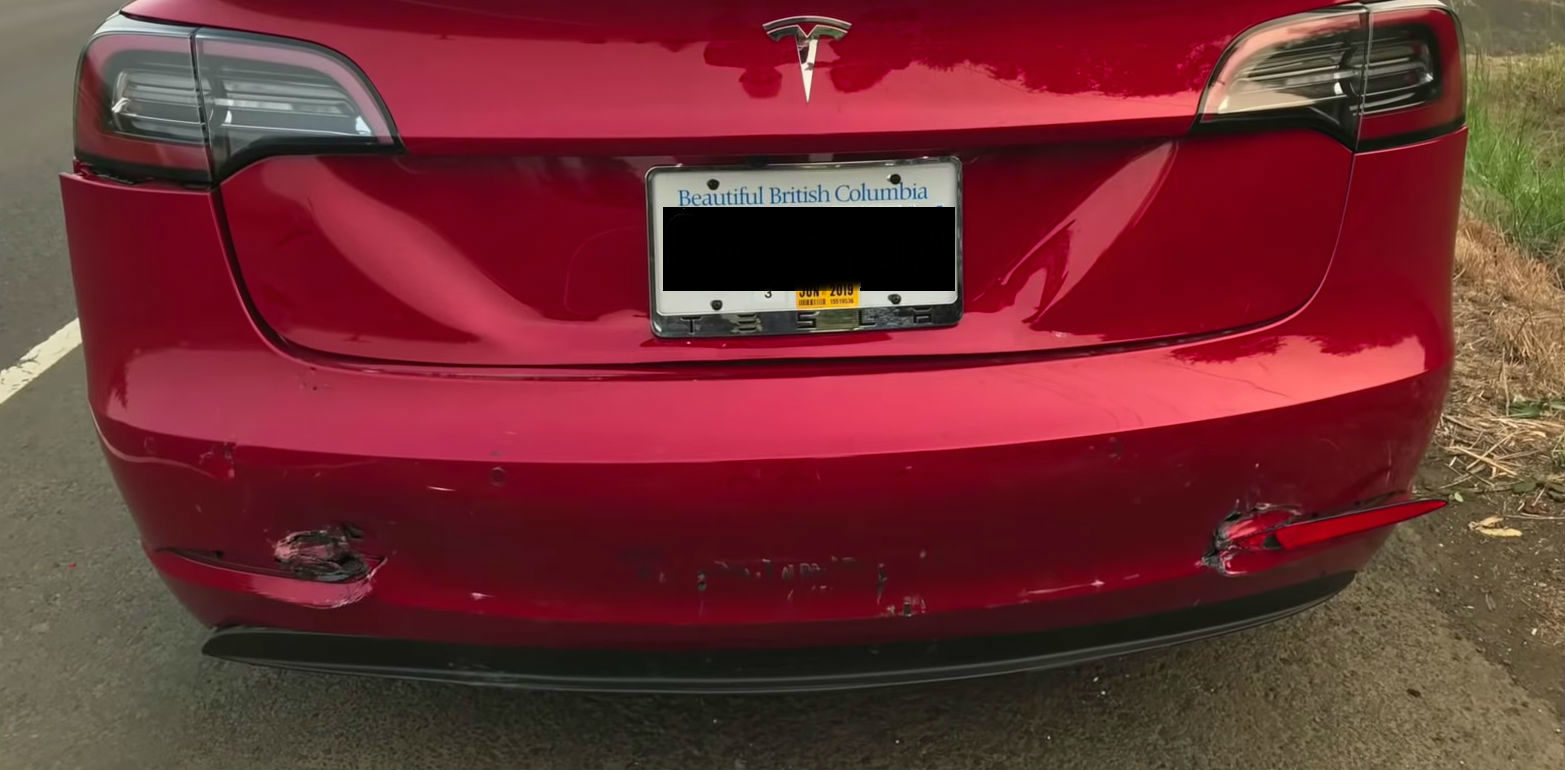
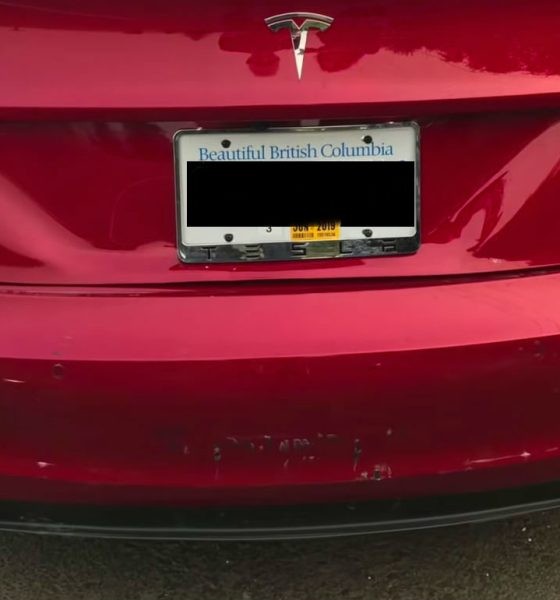
Lifestyle
Tesla shows proactive approach to passengers’ safety after Model 3 accident
Vancouver resident Peter Levey and his wife waited more than two years for their Long Range RWD Tesla Model 3. As part of their celebration for the new electric car, the couple embarked on what was supposed to be a multi-day road trip heading south to San Diego and back. Levey notes that the trip was two years in the making, and he and his wife were looking forward to it.
The first days of the road trip were everything that Peter and his spouse expected, plus more. On the first day of the trip, the couple headed to Portland, clocking in 322.3 miles on the road but only using 68 kWh of their vehicle’s 75 kWh battery, even with the A/C on during the entire trip. Unfortunately for Peter, the trip was unceremoniously cut short when a 4-door Dodge slammed into the back of their Model 3 at the intersection of Coastal Hwy 101 and Matlock Way in Oregon. The impact was notable, causing the Model 3 to get shoved 15-20 ft forward.
Authorities later informed Peter that the Dodge was likely traveling more than 40 mph when it collided with the electric sedan. The gas-powered car was significantly damaged, completely smashing its front end. Its hood was also bent at an inverted V, and its radiator was hanging out. The Model 3 showed far less damage. Multiple panels were dented, but apart from a couple of broken lights at the rear, the structural integrity of the vehicle was not compromised in any way. Peter noted in a video of the incident he uploaded on his model3man YouTube channel that even the contents of the Model 3’s trunk were unharmed by the collision.
Similar to other stories of Teslas involved in accidents, Peter’s Model 3 protected him and his wife well. They both escaped injury, and they were able to walk away from the crash without any problems. Inasmuch as this is impressive, Peter notes that what really struck him was how Tesla proactively reached out to him after the accident. For Peter, it was this approach to safety that truly made him believe how serious the company is about improving its cars and keeping its passengers secure.
“I have to say two things, and they are both about Tesla, the company, and their response to us. About a minute and a half to two minutes after the time of impact, my cellphone rang, and I looked at it, and I didn’t recognize the number — it was a 1-877. It turned out to be Tesla Roadside Assistance, and their first question was ‘Our computers show that you suffered a major impact. Are you guys okay? Were you in an accident?’ and I cannot tell you how comforting that was.
“It was just amazing. There we were — we felt alone, we felt isolated, we didn’t feel like talking to the guy behind us for obvious reasons, and there comes a call, and it’s from your car company. So we were incredibly impressed by that. And later in the afternoon, and later in the evening, Tesla Roadside Assistance worked diligently with us to try and get the car into Towing Mode, to give us everything we could try. It was most impressive.”
Tesla Roadside Assistance’s proactive response to the accident is just half of the story. A day after, Peter received yet another call from Tesla. This time, the call was from Tesla’s head of safety engineering, who asked if he and his wife were doing alright, and if he had any suggestions on how to improve the Model 3’s safety systems even more.
“The next day, when I got home from Vancouver, I got another call from the head of safety engineering, and he wanted to find out how we were. He also wanted to find out ‘What can we do to make this car safer? What can we do to give an even greater measure of safety to the occupants?’ and that was mind-blowing. I’ve never had that from any car company, and I understand why people now say the Tesla Model S, Model X, and Model 3 are the safest cars on the road.”
- Damages incurred by a Model 3 after a rear-end collision. [Credit: Peter Levey/YouTube]
- Damages incurred by a Model 3 after a rear-end collision. [Credit: Peter Levey/YouTube]
- Damages incurred by a Model 3 after a rear-end collision. [Credit: Peter Levey/YouTube]
Damages incurred by Peter Levey’s Tesla Model 3 after a rear-end collision. [Credit: model3man/YouTube]
Peter’s Model 3, whom he christened as “Red Dragon,” is currently in a Tesla-approved body shop to see if the vehicle could still be repaired. In a phone conversation with Teslarati, Peter stated that he hopes the wait for his vehicle’s repair (if it is indeed repairable) would not be too long. But even if it does take some time, he lightheartedly noted that he has a considerable amount of experience when it comes to waiting for his Model 3. Ultimately, Peter stated that he is sharing his experience not only to highlight the safety of Tesla’s vehicles. It is also about iterating how Tesla’s proactive response to its customers makes them a unique company that is both innovative and still incredibly emphatic.
“That kind of response inspires confidence among customers. They don’t abandon them when accidents happen,” he said.
Just like the Model S and Model X, the Model 3’s all-electric design does not feature a front-mounted gas-powered engine and a rear-mounted gas tank, which are found on conventional gasoline vehicles. The absence of the engine and gas tank acts as an extra large crumple zone that is capable of absorbing energy during high-speed collisions for. Apart from the ultra-high-strength steel and aluminum used for Model 3’s body structure, its floor-mounted battery pack provides further structural rigidity to the electric car. Earlier this year, the Model 3 was given a “Superior” front crash avoidance rating by the Insurance Institute for Highway Safety, which also praised the vehicle for its Forward Collision Warning and auto brake system.
Watch Peter’s YouTube video of his Model 3’s accident below.

Lifestyle
Tesla Model S Plaid battles China’s 1500 hp monster Nurburgring monster, with surprising results
There is just something about Tesla’s tuning and refinement that makes raw specs seem not as game-changing.

The Tesla Model S Plaid has been around for some time. Today, it is no longer the world’s quickest four-door electric sedan, nor is it the most powerful. As per a recent video from motoring YouTube channel Carwow, however, it seems like the Model S Plaid is still more than a match for some of its newer and more powerful rivals.
The monster from China
The Xiaomi SU7 Ultra is nothing short of a monster. Just like the Model S Plaid, it features three motors. It also has 1,548 hp and 1,770 Nm of torque. It’s All Wheel Drive and weighs a hefty 2,360 kg. The vehicle, which costs just about the equivalent of £55,000, has been recorded setting an insane 7:04.957 at the Nurburgring, surpassing the previous record held by the Porsche Taycan Turbo GT.
For all intents and purposes, the Model S Plaid looked outgunned in Carwow’s test. The Model S Plaid is no slouch with its three motors that produce 1,020 hp and 1,420 Nm of torque. It’s also a bit lighter at 2,190 kg despite its larger size. However, as the Carwow host pointed out, the Model S Plaid holds a 7:25.231 record in the Nurburgring. Compared to the Xiaomi SU7 Ultra’s record, the Model S Plaid’s lap time is notably slower.
Real-world tests
As could be seen in Carwow’s drag races, however, Tesla’s tech wizardry with the Model S Plaid is still hard to beat. The two vehicles competed in nine races, and the older Model S Plaid actually beat its newer, more powerful counterpart from China several times. At one point in the race, the Xiaomi SU7 Ultra hit its power limit due to its battery’s temperature, but the Model S Plaid was still going strong.
The Model S Plaid was first teased five years ago, in September 2020 during Tesla’s Battery Day. Since then, cars like the Lucid Air Sapphire and the Xiaomi SU7 Ultra have been released, surpassing its specs. But just like the Model Y ended up being the better all-rounder compared to the BYD Sealion 7 and the MG IM6, there is just something about Tesla’s tuning and refinement that makes raw specs seem not as game-changing.
Check out Carwow’s Model S Plaid vs Xiaomi SU7 drag race video below.
Lifestyle
500-mile test proves why Tesla Model Y still humiliates rivals in Europe
On paper, the BYD Sealion 7 and MG IM6 promised standout capabilities against the Model Y.

BYD is seeing a lot of momentum in Europe, so much so that mainstream media has taken every opportunity to argue that the Chinese automaker has beaten Tesla in the region. But while BYD sales this year in Europe are rising and Tesla’s registrations remain challenged, the raw capabilities of vehicles like the Model Y are difficult to deny.
This was highlighted in a 500-mile challenge by What Car? magazine, which showed that the new Tesla Model Y is more efficient, cheaper to run, and more reliable than rivals like the BYD Sealion 7, and even the nearly 400 KW-charging MG IM6.
Range and charging promises
On paper, the BYD Sealion 7 and MG IM6 promised standout capabilities against the Model Y. The Sealion 7 had more estimated range and the IM6 promised significantly faster charging. When faced with real-world conditions, however, it was still the Model Y that proved superior.
During the 500-mile test, the BYD nearly failed to reach a charging stop, arriving with less range than its display projected, as noted in a CarUp report. MG fared better, but its charging speeds never reached its promised nearly-400 kW charging speed. Tesla’s Model Y, by comparison, managed energy calculations precisely and arrived at each stop without issue.
Tesla leads in areas that matter
Charging times from 25% to 80% showed that the MG was the fastest at 17 minutes, while Tesla and BYD were close at 28 and 29 minutes, respectively. Overall efficiency and cost told a different story, however. The Model Y consumed 19.4 kWh per 100 km, compared to 22.2 for MG and 23.9 for BYD. Over the full trip, Tesla’s charging costs totaled just £82 thanks to its supercharger network, far below BYD’s £130 and MG’s £119.
What Car? Magazine’s testers concluded that despite BYD’s rapid sales growth and the MG IM6’s seriously impressive charging speeds, Tesla remains the more compelling real-world choice. The Model Y just offers stability, efficiency, and a proven charging infrastructure through its Supercharging network. And as per the magazine’s hosts, the Model Y is even the cheapest car to own among the three that were tested.
Watch What Car? Magazine’s 500-mile test in the video below.
Lifestyle
Tesla Cybertruck slapped with world’s least intimidating ticket, and it’s pure cringe
One cannot help but cringe and feel second-hand embarrassment at the idea of a person just driving around with a stack of these babies.

A Cybertruck parked at Stanford Shopping Center in California was recently hit with what might be the most try-hard piece of paper ever slipped under a wiper blade: a “fake citation” accusing the driver of supporting a “fascist car.”
The note, shared on X by Tesla staff program manager Ryan Torres, quickly made the rounds on X, where it quickly gained attention as an example of how not to protest.
The world’s least intimidating ticket
According to the citation, the supposed “violation” was “driving a fascist car.” The remedial action? Take the bus, call an Uber, or ride a bike. The note also dubbed Elon Musk a “chainsaw-wielding Nazi billionaire.” Now, protests against Tesla and Elon Musk have become commonplace this year, but one cannot help but cringe and feel second-hand embarrassment at the idea of a person just driving around with a stack of fake anti-Tesla/Musk citations.
Torres pointed out the irony himself in his post on X. Tesla currently employs over 140,000 Americans, and SpaceX has put the U.S. firmly back at the top of space technology. As Torres put it, maybe the person behind the world’s least intimidating ticket should “read a book on innovation before vandalizing” other people’s property.
Peak performative clownery
Not to mention that the fake ticket’s logic collapses under its own weight. EVs like the Cybertruck are literally designed to reduce emissions, not “destroy the economy.” If anything, Tesla has bolstered the United States’ economy by fueling jobs in engineering, manufacturing, and clean energy. It’s not the first time a Tesla has been the target of vandalism or politically charged notes, but this one stands out for sheer cringe value.
Torres summed it up neatly: “Peak clownery.” On that point, at least, the citation earns full marks. In a way, though, perhaps cringe fake tickets are not as bad as the literal firebombs that were being thrown at Tesla stores and cars earlier this year because some critics were gleefully misinformed about Elon Musk.
